This article was published in the Bloomberg Weekend Edition (© 2025 Bloomberg L.P.) on January 8th, 2025. Written by By Jinshan Hong, Josh Xiao, K Oanh Ha, and Danny Lee, with assistance from Spe Chen, Adrian Leung, and Jane Pong. Guy Rubin, founder of Imperial Tours, was a source used for this article.
The billions of dollars in spending that an unprecedented lifting of visa requirements could have brought simply hasn’t materialized.
China took the unprecedented step of easing visa requirements for scores of countries in 2024, now throwing open its doors to 1.9 billion would-be visitors. Only a fraction of the hoped-for tourists have come.
The influx of foreign tourists and the billions of dollars in spending they could have brought simply hasn’t materialized, a Bloomberg analysis shows. Visitors from the US and most of Western Europe — where political and trade spats with Beijing abound — stayed away. Instead, tourists from nearby Asian countries and less-developed markets came calling.
Foreign visitor entries to China totaled just under 23 million in the first three quarters of the year, according to a Bloomberg News analysis of the most recently available government data. While that’s roughly double 2023’s low base, it’s still only 63% of 2019’s same-period level and well short of the near full recovery Beijing would have been hoping for as it slashed red tape.
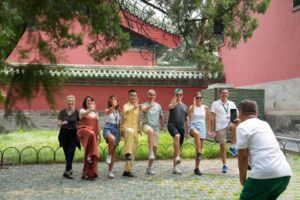
Italian tourists pose for a group photo after practicing tai chi at the Temple of Heaven Park in Beijing in July 2024. Photographer: Ju Huanzong/Xinhua/Getty Images
The reasons are manifold; far fewer international flights from overseas airlines, changing economic and political ties and a deteriorating perception in the West of China. For Beijing, the ramifications will limit its ability to prop up a sluggish economy and facilitate investment. It’s also a failed opportunity to project a better image abroad before tensions flare again as President-elect Donald Trump returns to the White House.
“China’s overall attractiveness as a tourist destination, and as a business destination, has been damaged because of Covid, Beijing’s policies and geopolitics,” Bloomberg Intelligence senior aviation analyst Tim Bacchus said. “The visa-free policy helps on the margins but it’s not making up for the fact that people are pivoting away from China.”
The precipitous drop in foreign visitors after the pandemic prompted China to unfurl the welcome mat in its biggest-ever tourism push. In the two years to the day since China re-opened its borders, Beijing has unilaterally relaxed visa policies to an ever-widening number of countries, despite its historical preference for reciprocal visa-free access.
China has now unilaterally extended visa-free entry to citizens of 38 countries. Before the pandemic, going to China sans paperwork was only allowed unilaterally for those from Singapore, Japan and Brunei. Beijing has also broadened a policy of offering visa-free entry for transit travelers who plan visits of 10 days or less. That currently applies to 54 nations.
“The fact they’re providing visa waivers to some countries’ citizens without reciprocity shows some level of desperation,” Bacchus said.
China’s Ministry of Culture and Tourism didn’t respond to a request for comment.
With a looming US trade war threatening Chinese exports, luring back foreign spenders is a critical pillar of President Xi Jinping’s grand plan to revitalize the world’s No. 2 economy. Beijing is battling its longest deflationary streak since 1999 as domestic brands are mired in price wars and Chinese consumers clock one of the world’s highest household savings rates.
Majority of China’s Visa-Free Perks Go to European Nations
Failure to convince Western travelers that China is a worthwhile holiday destination also risks deepening an isolation Beijing began when it closed its borders for three years during the pandemic. Since then, a series of trade spats have erupted between China and many Western democracies, with those hostilities now being reflected in a near decoupling of tourism ties between the Asian nation and the US and its allies.
Worryingly, the tourists China is attracting with its visa-free policies aren’t the big spending ones. At their peak in 2019, international visitors poured $132 billion into China, research by the World Travel & Tourism Council in partnership with Oxford Economics show. The organization estimates foreigners only opened their wallets to the tune of $98 billion in 2024, a 26% drop.
Guy Rubin, who founded Imperial Tours with his wife Nancy Kim in 1999, said his American clients now make up just under 40% of business compared with about 90% before Covid. Imperial Tours offers luxury travel throughout China, billing itself as a way to explore the nation’s heritage and high-end restaurants and hotels in style.
“Americans are generally scared of China,” said Rubin. “People individually say they’re not affected by geopolitics but we see very clearly the degree to which that’s untrue.” From dealing exclusively in China travel, Imperial Tours has had to add South Korea to the mix.

Photographers at the Zhangjiajie National Forest Park in Hunan Province on Jan. 5.Photographer: Deng Daoli/VCG/Getty Images
Rubin also said many Americans find the visa process “really tiresome.” “Our US travelers are taking advantage of the transit visa waiver programs, but we have to spend a fair amount of time explaining how they work.” Instead, healthier demand is coming from countries with better trade flows with China, like the Middle East, he said.
Even the people who are being drawn to China — of the almost 23 million foreign arrivals in the first nine months of last year, only a little over half, or 13 million, entered visa free — have initial reservations.
Alexandre Vadot, a finance analyst based in Tokyo, was one of them. The 28-year-old Frenchman traveled to Shanghai for a week in March in his first-ever trip and followed that up with another visit to Beijing in September.
While China was a lot more advanced than he thought, some things rankled, like people cutting queues. “When you’re born and raised in France or Europe, you have a not favorable image of China” based on media coverage, Vadot said.
At a national level, China doesn’t break down its tourist arrivals by country, but a Bloomberg Intelligence analysis of data from flight and ticketing analytics firm ForwardKeys, shows it’s people from China’s closest neighbors taking the most advantage. Round-trip bookings to China from Malaysia surged 69% in 2024 versus 2019, while those from Thailand increased 30%.
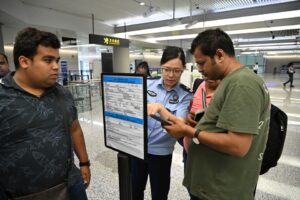
A staff member assists foreign travelers at Shanghai Hongqiao International Airport in August 2024. Foreign visitor entries to China totaled just under 23 million in the first three quarters of the year.Photographer: VCG/Getty Images
And despite most visa-free perks going to rich European nations, it hasn’t brought a crush of visitors. Round-trip bookings from both Germany and France plunged 38% while Italy sank 29%.
Xi is acutely aware of the benefits that having visitors witness the real China — one that is largely safe, cosmopolitan and rich in history — for themselves can bring. Speaking in San Francisco in November 2023 during a low point in China-US relations, Xi said that the more difficulties there are in the world, the “greater the need for us to forge a closer bond between our peoples and to open our hearts to each other.”
A closer look into tourist arrivals in Beijing, which does break down data by some nationalities, hints at what’s likely being reflected across the country. Around 10% of foreigner entries to China make a tourist stop in its capital city.
Similar to the round-trip flights booking data, it shows an influx of visitors from Malaysia and Vietnam, as well as Russia, probably as Russians find other destinations off limits due to sanctions. Canadians, the Swiss and the Germans are steering clear.
| Tourist Origin | % Change from 2019 to 2024 | |
|---|---|---|
| Vietnam | 283% | |
| Mongolia | 224% | |
| Russia | 158% | |
| Malaysia | 109% | |
| Thailand | 62% | |
| Indonesia | 46% | |
| Singapore | 24% | |
| Spain | 16% | |
| Pakistan | 8% | |
| Italy | 7% | |
| Myanmar | -7% | |
| North Korea | -12% | |
| Total foreigners | -18% | |
| New Zealand | -23% | |
| France | -27% | |
| Germany | -27% | |
| UK | -32% | |
| India | -36% | |
| Canada | -37% | |
| Japan | -40% | |
| Philippines | -43% | |
| Australia | -43% | |
| Sweden | -48% | |
| Switzerland | -49% | |
| South Korea | -51% | |
| US | -52% |
Source: Beijing Municipal Bureau of Culture and Tourism, Bloomberg
Note: Figures are adjusted by Bloomberg to account for a methodology change with the official data in June 2024. Both 2024 and 2019 data are from January to November.
One practical reality that’s limiting visitors is a dearth of flights, at least from international airlines. In 2024, international flights to and from China returned to 74% of 2019 capacity, according to data from aviation analytics firm Cirium. Among these cross-border connections with China, foreign carriers have resumed only 58% of their pre-Covid capacity, overshadowed by an 88% recovery rate by Chinese carriers.
European carriers can’t use Russian airspace and apart from taking a lot longer, flying around Russia incurs significantly higher fuel costs. Many have slashed their China schedules because that, combined with the lack of demand, makes the routes unprofitable. The airspace restrictions don’t apply to Chinese carriers, which have quickly filled the gaps left by exiting foreign airlines.
Even trips that don’t use Russian airspace aren’t particularly viable due to people’s limited interest in going there. Japan Airlines Co. Chief Financial Officer Yuji Saito said inbound travel to China is still only about 40% of pre-pandemic levels. “We think that will continue,” he said, describing it as the “new normal.”
Other airlines that have operated for decades in China have exited outright. Virgin Atlantic Airways Ltd. pulled out in July while Lufthansa, Scandinavian Airlines, Qantas Airways Ltd. and British Airways have also canceled routes as they became financially unsustainable.
“The market just isn’t there,” Cebu Pacific Chief Executive Officer Mike Szucs said. The Philippine airline has also dramatically cut back flights.
Shifting economic ties are a big reason behind the subdued demand. Western companies have been hesitant to ramp up investments in China due to growing regulatory complexity and geopolitical tensions, and that’s hampering travel too. Business travel bookings to China were just 52% of 2019 levels versus leisure bookings’ 79% recovery last year, the analysis of ForwardKeys data shows, and people who are traveling for work aren’t staying on to enjoy what else China offers.
Savanti Travel, a company specializing in business bookings, used to organize a lot of trips into China for international executives.
“Now, those meetings are in Tokyo or Seoul and they’re headed to other parts of Japan or Bali after their work trip,” founder Leigh Rowan, who used to run popular website The Points Guy, said. “It’s fundamentally changed.”
Around the world, people’s views of China have evolved, with fewer citizens from developed nations likely to hold positive views of the country’s economic impact and military prowess, according to a Pew Research Center survey.
Tourists from Japan, for example, are wary after a spate of attacks on Japanese citizens while those from the US and Canada, where anti-China sentiment has deepened, have noticeably stayed away. Washington and Beijing remain locked over a range of hot-button issues like Taiwan and the South China Sea, which is undermining business confidence and putting a lid on grassroots exchanges.
Airline logistics and geopolitics aside, China still remains a daunting place for many. English isn’t widely used even in hubs like Shanghai and Beijing, and the nation has its own mobile payments system that discourages cash and can be tricky to figure out without learning Mandarin. The internet is also heavily censored so sites like Google or Instagram can’t be accessed.
Claire Thum, a 27-year-old interior designer from Singapore, started to notice more social media videos featuring diverse landscapes and life in China. But despite a largely favorable impression of China in the small island nation, she’s held off from a trip, intimidated by the technology complications and language barrier.
“There are still a lot of hurdles to jump over.”
In May 2023, during my first visit to China after the pandemic, I was astonished by the development of Xi’an. “How Has Covid Changed China” chronicles the transformation of this previously unkempt city into a more modern metropolis of gleaming towers and high-tech zones interconnected by elevated expressways, metro lines and buses set on a canopy of lake-centred parks and green spaces. It was like time-traveling from 1980 to 2025 in the space of four years.
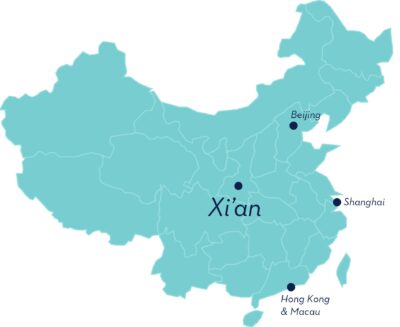
To understand the forces behind Xi’an’s incredible leap over the past five years, we need to look at government policy towards Xi’an over the past forty years, but particularly either side of the launch of the Belt and Road Initiative (BRI) of 2013. Prior to the BRI, exports routinely traveled from China to the rest of the world eastwards by ship. And as Xi’an is in western China, she was facing irrelevance and obsolescence.
China’s reforms of the 1980’s had led to a widely-celebrated economic boom along the east and south coasts where customs-exempt manufacturing zones located by rapidly growing ports were exporting a range of low-cost goods around the world. Meanwhile, because of poor inland infrastructure, foreign investors shied away from Xi’an which subsequently suffered slow growth and emigration. This imbalance was addressed by President Jiang Zemin’s “Go West Campaign” of 1999 which between then and 2006 prompted public investment of more than ~US$140 billion in transport, energy and connectivity to develop the attractiveness of western regions for investment. To forestall inevitable environmental complaints about this steel-woven carpet of concrete infrastructure, ecological protection along with education, were incorporated into the policy from the outset – over a million hectares of farmland and wasteland were converted into forest with farmers compensated for their resulting loss of income.
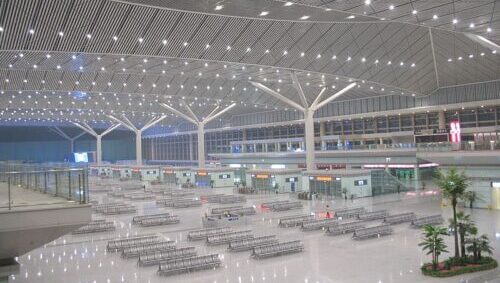
This long-term planning, a characteristic of Chinese governance, from two-decades ago is coming to fruition now. Apart from building smart new highways for China’s burgeoning middle classes and road-hauliers, a second airport terminal was completed in 2003 and a third in 2012. Also, Xi’an’s connection to China’s expansive high speed railway system, the largest in the world, was facilitated through the construction of Xi’an North Station. And again with an eye on the environment, investment was planned for a city metro system whose 9 lines covering 263 miles (423 km) opened between 2011 and 2023.
However, this first phase of development, pre-BRI, received a disappointing response from foreign investors. On the one hand, this was because the strategy had all been directed by the government which made western business people uncomfortable, and on the other, it was because it was ultimately misdirected. The billions spent on improving the infrastructure and educating the local workforce still did not compensate for the easy convenience of locating manufacturing capacity in the vicinity of the already established shipping hubs with their teaming populations.
This state of affairs was to be radically changed by President Xi Jinping, whose hometown is a one-hour drive from Xi’an. In 2013 he launched the Belt and Road Initiative (BRI), prompted by three separate factors. Firstly, China still needed to address the longstanding economic imbalance of its underperforming western regions. Secondly, Xi realized that China’s reliance on shipping for all its exports created a significant trade, economic and military vulnerability – any geostrategic rival could bring China to its knees by blockading the Malacca Straits through which nearly all China’s shipping passed. Lastly, as a result of the massive stimulus it unleashed following the 2008 financial recession, China had developed over-capacity in infrastructure-related capabilities, particularly in steel and concrete production. Coupled with a need to diversify its asset holdings from an over-reliance on US bonds, it saw an opportunity to leverage its infrastructural know-how through an international development loan and export program.
So what is the oddly-named Belt and Road Initiative? (BRI for short) Translated uncomfortably from the Chinese, “belt” and “road” refer to two different sets of envisaged trade routes. “Belt” describes the web of historic overland trading routes popularly referenced as the “silk road” linking Europe and China via Mongolia, Russia and Central Asia. This ancient commercial network has already been significantly rejuvenated through a gargantuan Chinese-built infrastructure program and even now continues to receive more investment from both China and participating countries. Xi’an has always been at the Chinese terminus of that network.
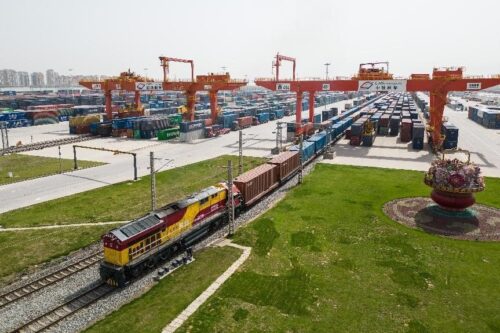
“Road” relates to a more logistically ambitious goal for China to access the Indian Ocean via complex corridors through South East Asia (particularly Myanmar) and via the adjoining Arabian sea through the Pakistan Economic Corridor. The westerly cities of Chengdu and Chongqing, which along with Xi’an form the “West Economic Triangle Zone”, are the gateways for this route. The BRI is therefore intended to increase China’s strategic resilience by reducing its reliance on the eastern and southern seaboards for exports. Of course, by reducing the cost and time to transport cargo from China westwards by rail to Europe, the BRI necessarily increases the attractiveness of western regions for foreign direct investment.
Although you wouldn’t know it from reading the papers, both foreign and local companies jumped at the logistical advantages of the BRI. The American company HP was an enthusiastic early adopter, proud to replace a 37-day journey from China to Europe eastwards by ship in 2009 with a 15-day journey westwards by rail ten years later. As a result between 2018 and 2019, rail volumes from Xi’an to Europe increased by a factor of 6! Then, in 2019 the volume of rail travel between Europe and China almost doubled. Suddenly, the western region boomed. And Xi’an was the place to be. In 2019, the government supported the rail project with an International Trade and Logistics Park along with a bonded area in an accompanying High-Tech Industrial Development Zone for cross-border e-commerce. Money poured in. Xi’an profited from US$31 billion of investment in private investment in 2019 alone. The city’s population grew from 6.2 million in 2013 to 8.8 million in 2023 and – despite the accelerated pace of construction – house prices rose 46% between 2016 – 2019. Similarly, the value of the city’s GDP or production tripled from US$57 billion in 2013 to US$156 billion in 2022. As a result of its fast population growth, Xi’an was able to extend its city limits and allocate more land to its fast-growing Qujiang District, where many of its new and soon to come luxury hotels are located. When I arrived in Xi’an in March 2023, having not been there since 2019, I was utterly astonished by the tail end of all that investment.

But Xi’an may well have hit its apogee just as Covid hit, because the pandemic has partly cut off the oxygen on which Xi’an thrived, namely foreigners’ access to the city. By June 2020, new business registrations had fallen by 40%. Tourism, along with equipment manufacturing and service outsourcing, was one of Xi’an’s pillar industries. Although domestic tourism provided some support, international tourism was completely interrupted from 2020 until March 2023, and because of reduced airlift to and from China, it is still only now beginning to recover. Furthermore, the conflict in the Ukraine and US sanctions on Russia have complicated Europe-bound rail logistics, though attempts are being made to create a new route that skirts Russia’s southern border across the Caspian Sea and the South Caucasus to Europe. Lastly, the economic and military standoff between China and the US has spilled into its relationships with Western Europe, Japan and South Korea, nullifying the Foreign Direct Investment on which Xi’an’s recent success and strategy has been predicated.
Following twenty years of continued investment Xi’an positively glistens. Expensively constructed government, commercial and residential buildings embellish a state-of-the-art infrastructural plan of social utopianist promise. However, tourism, a pillar industry, and reliance on continued foreign direct investment are being held hostage to the geopolitics of the moment. Without some kind of thaw in China’s relationship with western countries, Xi’an’s regeneration and even the ingenuity of the BRI are liable to stagnate. I and many Xi’an residents hope the world can find a way to avoid this fate.
4 years ago I co-founded Imperial Tours, an inbound luxury tour operator in Beijing, where I lived for 20 years. As a result of the Covid pandemic, I was trapped outside China from November 2019 until three weeks ago when I returned for the first time in over three years. This article describes the changes I found on reopening China’s travel industry.
The Rise of “Genuine” Boutique Hotels
When China first opened to the travel industry in the 1980’s, one of its only sources of foreign currency was the inbound market. Since that beginning the impact of overseas tourists was factored into every decision in the development of the hospitality sector. During Covid however, China was shut off from the outside world and as a result the hospitality sector advanced within its own bubble.
There has impacted a number of things, but one of the most notable has been the rise of the genuine boutique hotel. I write “genuine” because at the first boutique hotel conference in China (at which I spoke), boutique hotels were defined as having up to 100 rooms, which is not how most western travel agents would understand it. However, after being closed off by Covid for more than three years, the spending of affluent upper Chinese classes traveling domestically has caused a mushrooming of interesting boutique hotel alternatives both outside big cities (prompted by the local staycation market) and in China’s longstanding leisure destinations.
There’s of course one problem generated by this organic growth – in many instances, these boutique hotels are ill-equipped to handle foreign visitors. Yangshuo Misty Wonderland Hotel is a perfect example. This luxurious 28 key hotel comprised of villas and very spacious rooms with generous balconies sporting their own capacious baths offers one of the most stunning, if not the most spectacular, view and location in the entire country. (Above photo is of me sitting on a bench located within an ornamental swimming pool in front of the mountainscape.) Not bad, right?
Buildings are styled on the traditional architecture of the Han and Tang dynasties. Yet not only is there not a single staff member able to rub two words of English together, but there are no western dishes on any of the hotel menus. There is no concession anywhere to the potential demands of a non-Chinese speaking tourist – something that would have been unthinkable prior to Covid.
The same is true at the delightfully landscaped Tong Resort in the same area. But do not lose hope – Jora, a 35 room “Small Luxury Hotel of the World”, in the same area had the most resourceful staff at any hotel I have ever encountered and accommodates English speaking guests.
As we move beyond the first phase of China’s reopening, the re-introduction of overseas tourists to China’s inbound market coupled with the reduction in demand from the domestic traveler, will inevitably encourage this new wave of Chinese boutique hotels to invest in services for overseas travelers which can but enrich the market and textured experience of travel in China.
Fewer QR Codes And More Real Menus
If you’re anything like me you stifle an internal groan when you walk into a restaurant and are compelled by the waiter to scan a QR code to browse online to the restaurant menu, which you subsequently peruse with difficulty on your annoyingly limited mobile phone screen. This was a digital innovation introduced during Covid to reduce the spread of infection.
I object to the impersonality of this characterless functionality, and so am cheered by a trend in techno-addicted China tilting in the opposite direction. When I went to dine at Michelin one star, Poetry Wine, I was thrilled to be handed a thick, large format volume with a photo of each dish with its name, price and ingredients printed on individual pages of high-quality paper.
I was dining amongst a group of friends and we all started to discuss the menu and our choice of dishes. The menu prompted an entertaining conversation that became the foundation of a hearty and enjoyable dinner. Ignace Lecleirc, a successful restaurateur and owner of a wide stable of Beijing eateries including the fabulous Michelin one star fine-dining establishment, Temple Restaurant Beijing – Hutong, assures me that this trend is now becoming well-established.
A New Digital Divide In China
When people speak of a digital divide they typically refer generationally to the elderly failing to keep up with the technology of the day, not the bifurcation of American and Chinese internet systems with their separate app universes. Whilst I can travel freely between western Europe and America and use the same apps such as Uber, Booking.com, Google Maps and Whatsapp, that borderless digital experience totally collapses at Chin’s border.
Not only do all apps owned by Google or Facebook not operate in China, but moreover, China’s digital universe is comprised of an entirely different set of apps. For navigation, you would use Baidu or Gaode, the first of which does not even seem to be available to non-China registered accounts. Restaurant recommendations are on Dianping. Ride hailing is on Didi, payment services rely on Alipay or Wechat and ctrip would be used for travel bookings. It’s an entirely different app universe and with the exception of ctrip, which offers trip.com outside China most of these apps are not going to be easy for the traveler to use in China because of linguistic and logistical barriers.
What this means in practice for overseas travelers, for example, is that whilst travelers can always get the hotel concierge to order them a cab to a restaurant, which the concierge would still be required to suggest (as travelers cannot access Dianping’s restaurant suggestions for linguistic reasons), for the return journey, travelers would require the restaurant to order them a cab back to the hotel. It seems that most cab drivers are accepting cash, so payment in that situation is not an issue. However, travelers can no longer presume to be able to hail cabs as these are mostly responding to ride-hailing apps now. These are the kinds of considerations that travelers will need to incorporate within their journeys through China. Increasingly, access to China’s digital services is leaving overseas visitors behind.
Like an anxious child fearing the loss of his mother, so on my most recent trip did I worry about how I might possibly negotiate life in China without my mobile phone. As I participate within China’s digital universe, I understand its reach and ubiquity such that on the one hand I fear for travelers who cannot access it and on the other, I am subsequently insensitive to situations where overseas travelers, particularly independent travelers making their way without the help of a local operator, might struggle with the most basic aspects of digital life there.
Of course, no article on the Chinese internet is complete without emphasizing the need for overseas travelers to equip themselves with a solid VPN service prior to travel there in order to access their favorite western web sites and services. Indeed, I would now recommend travelers subscribe to two different VPN services so that in the event one is blocked or ineffective, they always have the other to turn to and use to gain access to Instagram, Facebook and Google, etc.
The New Greater Bay Area
This is something that has not garnered attention in western media but deserves mention. The Chinese government first documented its intention to create a Greater Bay area in 2017. The idea is to integrate Hong Kong, Macao, Guangzhou, Shenzhen and five lesser known successful, southern cities within an environmentally sustainable and technologically progressive development plan. And when the Chinese government decide on these strategic plans, there’s usually good reason and they usually happen.
So here we are six years later following the construction of interconnecting high speed rail links, bridges and airport clusters along with new rules facilitating the movement of people and goods between these areas. For the travel industry, our attention needs to be focused on Macau in particular as this has been designated the travel hub within the plan.
Already known as a destination for gambling, following a recent crackdown on junkets (associated with money laundering), Macau is seeking to develop alternate revenue streams. Las Vegas provides obvious direction, but in addition, I have been told, significant funds are soon going to be devoted to promoting recreation and the arts across this area.
This message was echoed by Meg Maggio, an art aficionado of many years standing in Hong Kong, who advised that big plans are afoot in the world of art across the entire Greater Bay area, not just Macau. How this will impact travel we will wait to see, but it’s worth just mentioning now.
The No-Show of Outbound Chinese Travelers
As this is relevant but unwelcome, I will cover it briefly. Major travel suppliers in the west might have been expecting a sudden rush of Chinese clients in the wake of China’s re-opening. I am sorry to report that this won’t be happening in the immediate future. As a result of political tensions, countries have been grouped into friendly and unfriendly sets, with Chinese outbound groups able currently to travel only to those deemed friendly. France qualifies as friendly, but UK and US do not for example. Whilst FIT travelers can travel freely, groups are subject to this restriction. I would anticipate that the warming of international relations will quickly address this lagging stricture.
We are still of course very much in the early days of China’s reopening and many of the apparent obstacles, such as the continuing lack of trans-Pacific flights, will surely be bridged in due course. As that happens, no matter if you have already been to China many times, like me you will always find that it has shifted in your absence and that there’s always something new to discover and enjoy.
First published in Insider China Report on June 13, 2023.
Scott Kronick left home comforts to set up Ogilvy & Mather’s office in China over twenty years ago. Since then he has advised the world’s leading multinationals at the highest commercial and political levels and now leads an organization of 300 across 6 offices. A new expert on Imperial Tours’ roster, we asked him for his inside view of China.
Imperial Tours (IT): We all know there are many misperceptions and inaccurate myths about China. Which exasperates you the most?
Scott Kronick (SK):There is a saying that people who are here for a week can write a book, people who visit for a month, can write an article and people here for years can barely explain the many intricacies of China in a sentence. There are so many China narratives. If you are someone that deals in just black and white, China is a hard place to live because there are so many ambiguities. The biggest issue I have is with people who try to explain China is one way or another and are quite convinced of their positions when there are really many narratives about China. For example on one hand people could argue China is a developing country. And there are many proof points to make that argument. Others can argue that China is very much a developed country. There are many proof points for that too. It really depends on what lens you are looking at this and both positions are both right and wrong. The myth that China is one way or another is what exasperates me as I believe there are many ways to explain China and it depends on many different factors.
IT: What is the next technological horizon that China will reach before the rest of the world?

SK: I think we need to watch for the advent of 5G, cloud services and autonomous driving. I think you are going to see China take the lead in many of these areas.
IT: What do you see as the three biggest differences between the China of 1995, when you first arrived, and the China of today?
SK: I think the biggest difference is the mindset of the people. As China has opened itself up to the world, people have been exposed to much more and they have become more sophisticated and experienced. Given that China has one of the largest outbound travel markets, it is only natural that people are getting more global exposure and this in turn has had a huge impact on how consumerism has evolved in China. In my line of work, I think one of the biggest things I have taken note of is that the modern Chinese consumer is much more discerning, more brand aware and increasingly more demanding, and that wasn’t the case in 1995.
IT: To what extent these days does China still react to trends coming from other countries or are you now starting to see China as something of a trend setter?
SK: Historically much of China’s innovation came from ideas originating elsewhere, but that has changed dramatically in the past 10 years. Particularly in technology and biotechnology, there is a ton of innovation taking place in these sectors. Just look at the online payment solutions business, China is more advanced than anywhere in the world and this has taken place only in the last several years.
IT: If you were traveling to China for the first time – what would be the top thing you would want to do?

SK: Of course the Great Wall is a must see, perhaps a hike on a less developed part of the Wall is a very special thing to do. But, I couldn’t just pick one thing. I would also say the food in China is so distinctive and diverse. I love Chengdu for its food, for the Panda reserve and for the warmth of the people. That would also be a must see. I also love walking around the cities – Beijing, Shanghai, Xi’an and Chengdu have so much to offer.
IT: What drives your passion for China? Why have you stayed in Beijing for so long?
SK: Working in China is like a drug. Every day you learn something new. There is such ambition and optimism you feel the future is being created every day. I love that.
Whilst travel companies typically extol monuments of the past, China’s attractiveness as a destination extends to its impact on our children’s future. For the past few months we have been looking into the folds and contours of China’s evolving landscape. Previously we looked at the revolution in smart phone apps and payment systems, at leapfrogging technologies in retail and at the development of Artificial Intelligence. Expanding upon the concepts of future, we sat down with Will Beloe, a Global Product Specialist at the International Finance Corporation (IFC), an arm of the World Bank, to discuss China’s approach to the environment. Will has been covering China for nearly two decades and for the last five years has been responsible for driving green investment in financial institutions in developing countries across Asia, including China.
Guy: Why do you think China is taking environmental issues so seriously? Is this a national or global concern?
Will: China is taking its environmental issues very seriously primarily because the country’s narrow focus on economic growth over the last 30 years has pushed its ecologic system to a breaking point. Anything between 3-9% of GDP is lost to pollution (air, water and soil) per annum. China’s government knows all too well that it has an obligation to protect its people from such harm. Climate change is a layer of costs and risks on top of that.
Guy: Are there any areas of green growth where China is leading the world?
Will: China makes 2/3rds of the world’s solar panels and nearly 1/2 of the world’s wind turbines. China had more battery-only electric car sales in 2016 than the rest of the world combined. 1 million Chinese are employed in its solar sector.
Guy: In what areas of climate change is China contributing to a global solution?
Will: China is driving green growth for two reasons – it has tot clean up its soil, water and air, particularly in its mega-cities; and because it is now a market leader in many of the areas. China is beginning to stand tall in areas including green finance. The work IFC has done with local financial institutions (FIS) has led to a reduction in emissions over 50 million tons of greenhouse gasses PA. This is more than our work with other FIS around the globe combined.
Guy: In your field of endeavour how well does China integrate its work with other countries?
Will: Under Xi Jingping, China is no longer 韬光养晦 (hiding one’s light under a bushel). China has bid its time beautifully on the emerging green economy and is now leading the world in many areas, such as those already listed above. It is likely to do the same in the carbon markets (this will take a few more years), in clean green cities, in water management etc.
Guy: In what areas is China a threat to the rest of the world environmentally and in what areas is it a force for the good?
Will: Depends on whether your glass is half-full or half-empty. China is facing some of the world’s biggest problems when it comes to pollution (second only to India). Given its recognition of these threats and the position the government is in, it has the potential to solve these problems in a way that most other countries could not. The solution it implements will do more than most to help put us on track to avoid the worst climate change scenarios, and it will provide a hugely valuable template for others to follow. There are complaints of China dumping solar panels/wind turbines and in the future probably electric cars in other countries. In the end, how bad is that for the world?
Guy: How do you think China could improve in its interaction with multilateral organizations in the area of environmental research, policy formulation?
Will: It has been stymied in its attempts to grow its engagement with already established multilateral organizations. As a result, it ahs ended up establishing a number of its own. Net net, this is likely to be a positive for all but the incumbents.
Guy: How do you view the future of China’s environment and the impact China will have on the earth’s resources and environment?
Will: I am optimistic that China will manage to deal with its population and climate problems faster than almost all other countries will and could. By doing so, it will provide leadership and a roadmap to others. It is an excellent ‘soft power’/economic opportunity that is not lost on its leadership.
Guy: Thank you for your honest opinion and perspective Will, we are looking forward to what the future of China holds.
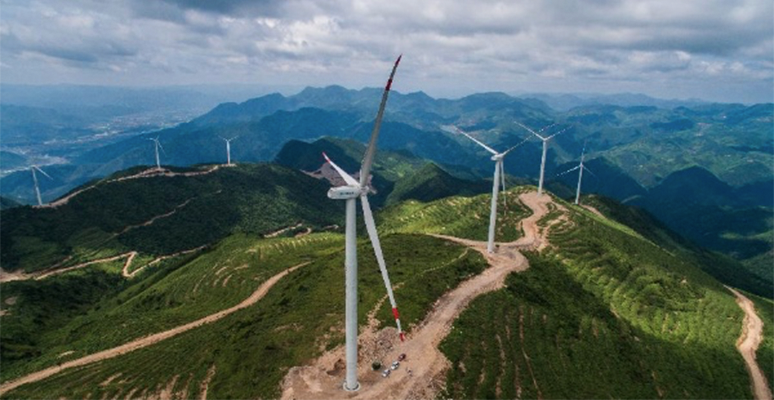
China is heavily investing in technologies for the future across all spectrums of industry – from renewable energy, medical advancements to transportation. Imperial Tours has collected a roster of experts to showcase the dynamic transitions China is making as a global player. We can arrange for you to meet these experts to discuss and learn about China’s political and economic strategies and investments in technology.
The Retail Revolution
China has fast become the holy grail of shopping. Be it high-end or low-end, costly or counterfeit, China is the place where you can find just about everything. In the last decade, the biggest manufacturer in the world has developed the largest consumer base globally. This large population of freshly minted consumers has caused luxury retailers to scramble for a piece of the pie, or should we say, cookie? While sold out Louis Vuitton shops and limits on how many Rolex’s one customer is allowed to buy have been picked up by Western media, another retail revolution has prospered largely unnoticed within China’s borders; online shopping. With $900 billion in sales in 2016 alone, and responsible for almost 47% of digital retail sales worldwide, China has eclipsed the US and is now the largest online retail market in the world (Retail & Ecommerce, August 18, 2016). The story of how this rapid growth in retail evolved is almost fatalistic, with multiple companies taking advantage of an economic environment primed for shopping.
From Zero to Hero
In comparison to many Western countries, wealth and technology are relatively new to China. A significant portion of the Chinese population only began to experience a degree of economic prosperity in the mid 2000s. The rise of the middle class in China has been rapid. During this time of economic expansion, the number of households with an annual income of US$11,500 – US$43,000 grew from 5 million in 2000 to 225 million in 2016 (Economist, 2016). Along with this increase in wealth came an increased demand for technology. Instead of having to go through the technological steps Western consumers went through from gramophone to an iPhone, the first digital contact for many Chinese was either a smart phone or a tablet. However, since almost no digital or retail infrastructure had been built, and with no old infrastructure to tear down, Chinese companies who were able, were in the prime position to take advantage of this technological vacuum. From start-up delivery firms to creating new payment systems, this period laid the foundations for the new digital era.
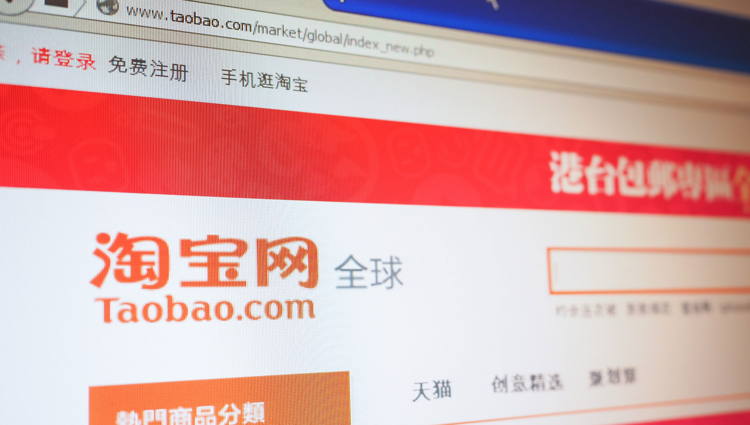
Taobao – a populat online shopping site in China
Enter the Giants
The three largest online players in China presently are JD.com, Tmall aka Taobao (Alibaba) and WeChat. JD.com went online in 2004 and is the largest competitor to Alibaba-run Tmall, which was founded a year earlier in 2003. Both companies are B2C online retailers who have pretty much taken over China’s online retail market. While JD.com prides itself on having better quality controls on their brands and goods than their competitor, Tmall currently holds a larger portion of the overall market share and has deeper pockets financially. Alibaba, the parent company of Tmall became the largest global IPO ever when it went public in the United States in 2014. Combined, these two companies are the Chinese equivalents of Amazon and Ebay, the only difference being that their customer base is over one billion online savvy shoppers.
Enter WeChat, the super app. WeChat was first released in 2011 by its parent company Tencent, and with 850 million active users, it is now China’s most popular instant messaging application. While the logo and the name of the app look and sound similar to the American WhatsApp application, it is vastly different in its functions and capabilities. The best way to describe WeChat is a combination of Facebook, WhatsApp, Apple Pay, Instagram, TripAdvisor, SkipTheDishes, and online city services combined, but without the advertising. While this sounds quite chaotic and confusing, at its core WeChat is an instant messaging app with all other functions neatly hidden within. While WeChat is not an online retailer itself, it has created its own mobile payment system (WeChat Pay) and has a larger user base than Tmall or JD.com. However, recently WeChat has ventured into creating an online store, which soon could rival its competitors.
For these three companies China has become the digital ‘Wild East’ where opportunities abound. With more and more economic prosperity as well as a savvy online population, the e-commerce environment in China is the perfect breeding ground for digital entrepreneurs to thrive. Right now, between these three giants there is fierce competition for supremacy.

Online apps and sites It has become easier than ever to shop from anywhere
Shopping with Chinese Characteristics
In addition to a rich economic digital landscape, China’s unique political and economic landscape has resulted in oddities and strange paths to purchase.
One of these oddities is the phenomena of the Daigou, which literally translates to “buying on behalf”. Daigou’s are people living overseas who purchase luxury goods as well as items that can be hard to purchase in Mainland China like foreign baby-milk powder, and then sell them to customers living in China. These luxury items can be up to 30-40% more expensive in China and the Daigou either make a profit on charging a small fee for the service or claiming the tax refund. WeChat is the primary platform for Daigou to communicate with their clients as well as transfer money. Diagou is a huge business estimated to be worth around US$12 billion. Approximatley 80% of Chinese luxury purchases are made abroad and a survey of luxury shoppers has found that 35% of customers have used a Daigou to purchase goods online while only 7% used the brands’ website to do so.
Another oddity about Chinese people’s shopping culture is that there is very little trust in direct marketing and advertisement. This mentality has led to the rise of Key Opinion Leaders or KOLs. These are Chinese online influencers, similar to Bloggers or Vloggers in the West, who maintain trusting relationships with their often large fan base. This phenomenon has resulted in many companies hiring KOLs to endorse products or place ads in their feeds to market to their fans. Working as a KOL can be quite profitable if your fan base is large enough. For instance, KOL Papi Jiang, has a following of over 24 million fans on Weibo (China’s equivalent to Twitter) and was paid US$3.4 million for a single ad in 2016 (China Skinny 2016). While Papi has managed to amass her millions of fans through witty commentary and funny videos, other KOLs have made themselves experts on specific brands or items and often attend fashion shows to share their knowledge and expertise with their followers. One of these expert KOLs is ‘Mr. Bags’ a 24-year-old Beijinger with over 2.7 million followers on Weibo. Using his influence he claims to have helped brands sell over US$170,000 worth of designer bags in just 12 minutes (Business of Fashion, 2016).
Both Daigou’s and KOLs are phenomena that have emerged as a result of the unique position of the Chinese economy and its cultural past. While the world has opened up its markets to Chinese made products, not all foreign made products have found a way into the Chinese market yet, which has created a niche for the Daigou. Additionally, decades of state propoganda has made the Chinese population suspicious of anything written on billboards or aired on TV resulting in the rise of the KOLs.
Digital Destiny
In 2015 China’s e-commerce share of global sales were almost double that of the United States at 22.2% to 42.8% respectively. However, it is estimated that by 2020 China is on course to take up to 60% of worldwide e-commerce retail, while the United States share could drop as low as 17%. With an ever expanding middle class, with more disposable income, greater mobile and internet penetration into rural areas and growing competition of e-commerce players who are constantly improving logistics in China, infrastructure and payment systems, the environment for online retail is perfect. Additionally, one of the most astonishing aspects of this digital shopping revolution is that in 2016 more than half of all e-commerce transactions and sales in China were conducted on a mobile or tablet. Reading the signs on the retail horizon, it is a safe bet to predict that China’s shopping destiny is digital.

If you believe the media, there is never a good time to travel to China. We hear repeatedly about China's lack of political freedom but rarely about China lifting 680 million people out of poverty over the last 30 years. What about the very real economic liberty that brings? Every spring, we hear about various flu's from China killing a small number of people. This is often spun by the local WHO office and the media as a major risk to the world's health, but we rarely hear of medical breakthroughs from China, whether the latest malarial cure or the first ever children's vaccine for Japanese Encephalitis. We hear often about China's backwardness but rarely about its progressiveness, for example being the world's biggest investor in renewable energies, nanotechnology and other developing sciences.
The press is paid to be critical rather than representational and China is one of the biggest stories of our lives, as a result of which there is a lot of critical, rather than representational, information about it. If you believe the press, there is never a good time to travel to China because it is constantly plagued by epic problems, most of them life-threatening. To be misled by the hype is to miss one of the most positive developments of our lifetimes. Remember – not a single journalist, not one, foresaw the thirty-five year rise of China. Most of them have spent this period predicting its "inevitable" implosion, explosion, demise, hard-landing, collapse… the tiresome list goes on and on. And yet I, having lived in Beijing for nearly 20 years, have had the fortune to experience a good part of this incredible national transformation.

At the same time, over the past ten years, there has been a phenomenal investment in China's hotel industry. China now boasts some of the most spacious, luxurious and beautiful hotels in the world. The Shanghai Peninsula Hotel is often celebrated by magazines and travel agencies as one of their favorite hotels in the world. When you compare the rates of these hotels to what is available in other destinations, you will realize the incredible value that China offers at the high end, in some cases charging as little as a fifth of the price of comparable hotels elsewhere in the world. Unfortunately, this cannot last indefinitely. As the local Chinese market develops both economically and in terms of brand awareness, many of the five star hotels in China will increase their prices towards global norms. And by the time many overseas travelers realize how amazing China is and the availability of these magnificent properties, the window of opportunity will already be starting to close. I estimate that in five years, a luxury tour to China will cost double what it costs today for exactly the same inclusions. Hence, you will be saving yourself 50% of the total tour price by traveling now rather than waiting for the media to tell you a good time to go.
 Managing its image with the outside world for the opening ceremony of the Beijing 2008 Olympics was a masterful stroke for China. I know the man who was in charge of PR for the Olympics, and when I put it to him that China would be well advised to continue to project that image on an ongoing basis, he cautioned that the government would never allow it. What is one to make of such a country? How can one operate in it? And what’s it like to work here?
Managing its image with the outside world for the opening ceremony of the Beijing 2008 Olympics was a masterful stroke for China. I know the man who was in charge of PR for the Olympics, and when I put it to him that China would be well advised to continue to project that image on an ongoing basis, he cautioned that the government would never allow it. What is one to make of such a country? How can one operate in it? And what’s it like to work here?
Bear in mind that when I first arrived in China in 1994, its foreign exchange reserves were US$50 billion. These days, the Chinese government tries to keep them down at the US$4 trillion mark. Socially, it was composed differently. Then 300 million people lived in a city. Urban dwellers now number more than 700 million. And whereas in 1994 there were hardly any internet users, with over half a billion users China now boasts not only the largest internet market in the world, but also some of the world’s most exciting and innovative technology companies. These numbers, economic, social and technological, point at the frantic evolution Chinese society has undergone over the past twenty years. They hint at two paradoxes lying at the heart of Chinese society today.
On the one hand, a constant in the evolution of Chinese society over the past century is the inevitability of change. On the other, a traditional form of government is managing and effecting that change. Whether it is in extremely fast-paced industries like internet, bio-tech or telecoms, or slow-changing concerns like concrete, media and power-generation, decisions are subject to government processes and values that are the product of centuries of political history. The meaningful take-home is that visiting business people should respect this different and effective way of doing things. Increasingly confident these days, Chinese business and political leaders will walk out of meetings at the first sign of an affront, and with their exit goes every chance your company has of doing well here; something one should not forget.
The second paradox is as important to understanding China. Although she is the world’s second largest economy (and will in a few years eclipse that of the United States), China in per capita terms is still a surprisingly poor place. Indeed, she is the ninety-third wealthiest, somewhere between Thailand and Turkmenistan. A collared shirt in a nice, middle-class shopping mall in central Beijing will cost about $90. By contrast, a pair of shoes in a rural village will cost about US$1. The take-home for you is that China is a big country with a wide range of socio-economic groups. A savvy operator will alter her behavior according to the provenance, age and experience of her Chinese interlocutor. If you’re not sure how to behave, tend towards conservative and respectful behavior and you won’t go wrong.
As a non-Chinese reading this article and thinking about what it might be like to work in China and to interact with people here on a professional basis, please think about the above two paradoxes in the context of a dynamically changing society. For, example, how differently might you behave in a meeting with a 70-year-old man as opposed to a meeting with his 30 year old granddaughter?
Our septuagenarian, likely born to a large family, would have spent his first years in a traditional Confucianist Society with outdated practices such as foot-binding, as little food as there were human rights, and invading foreign forces ravaging the nation. Following the civil war in Mao’s China, he would have worked for an egalitarian state-owned company where there was little salary difference between the CEO and factory worker. In that capacity, he experienced the disastrous effects of the Great Leap Forward and Cultural Revolution, before his situation improved during the reform process. If you are meeting with him in a professional capacity at a senior level, given his age, it is likely he is powerful and has been through things you can’t even begin to imagine. Don’t be fooled by his shabby suit and nylon socks, you want to accord this individual the respect he fully merits. Give him a gift at the first meeting, use your common sense on what he will like and shower him with compliments that you feel to be true. Don’t flatter for the sake of it, but express your admiration for what China has achieved and for what he or his company have achieved. Stay on safe subjects – don’t be critical about China, don’t offer your view of what they could do better, indeed don’t offer advice unless you are asked for it. Be friendly, positive and respectful. Everyone knows you are a foreigner in China, don’t know where to sit, what to eat and in what order, how to behave, etc., so just be yourself, be genuine and, most importantly, be respectful. (If you are a guy and are invited to consume alcohol in a series of toasts, there is a strong expectation for you to do so. If you don’t drink, then do say so, but you might explain it by saying you have a health complaint and ask an associate to toast for you. Drinking and business meetings is a whole other subject!)
Now let’s take a look at his 30 year old grand-daughter. An only child, gifted iPhones, iPads, Nike trainers, a wonderful education and the latest gear by her grandparents and parents, she also suffers from their attention to her career success. Less bound by the constraints of traditional Confucianist norms, she has known nothing her entire life other than economic success and an exuberant, burgeoning capitalist society. As a woman she has far more opportunities than her mother or grandmother might have enjoyed. If she is successful and has some good connections, she works for a state-owned enterprise because these offer the highest salaries and the most job security. If you meet this person in an unusually senior capacity, it’s not unlikely that this person is very well-connected, is on the way up and that this post is a stepping stone to the next position. Someone in that background is likely to conduct the meeting with you in English rather than Chinese and don’t be surprised that their English is flawless. What makes this meeting both a lot easier and a lot more difficult is that they are on your wavelength. Although you should stick to the same rules as those expressed with the septuagenarian, you will naturally fall into a more direct mode of expression with less of a dance. What you need to watch out for here is to re-confirm all aspects of what you have agreed. Whilst your interlocutor can switch to your radio frequency with ease, that does not mean her company will follow suit and so make sure you summarize a check-list of everything you have agreed at the end of the meeting and then follow up with an email. There is a likelihood your matter will be handed to a deputy, and so you need to double-check everything you have agreed with the deputy. Don’t be surprised if it feels like you are starting again.
In conclusion I should put these thoughts into the context of the Rule of Law/Rule of Man debate, and what that means for you as you anticipate doing business here. China has one of the most extensive legal codes in the world. It is to all extent and purposes almost impossible to do anything business-wise in China without breaking some regulation. By way of explanation, there is a comparison to be drawn between low-trust societies that have extensive legal codes that few observe strictly, for instance Spain, Italy & India and high-trust societies, such as those in Northern Europe, with more selective legal codes that are more rigorously observed. As a result business people coming from high-trust societies may feel at sea doing business in China, whilst those coming from low-trust societies will be at an advantage. To give an example, although prestigious GMs from western Europe are much admired by Chinese hotel owners, in my experience some of the most successful hotel GM’s in China hail from low-trust societies like India, Egypt, Morocco and Turkey, precisely because they find it easier to tune into the Chinese way of doing things. There are rules and regulations, but these are prioritized and are there to create a playing field rather than delimit it.
It is not the rule of law that determines the structure of an industry, but the interaction between the rule of law and man. This brings me to a second key point. A country still grappling with how an independent judiciary might fit into its party-led political system is by definition a low-trust society. As a result, in modern day China, contacts are key. Whilst the legal system will afford you a measure of protection, don’t be fooled into thinking it gives anything approaching full security. This is a hard business environment for non-Chinese to be sure and when push comes to shove both in terms of setting up your business, operating it and defending its ownership in the event of its success, your network of contacts are highly useful.
A version of this article was first published on the Extraordinary Events Blog [link to http://worldofextraordinaryevents.blogspot..com/2014/04/working-in-china-style-and-product.html] on April 16th, 2014. Guy Rubin is the Managing Partner of Imperial Tours, which has been named SuperAgent by Travel + Leisure for the third consecutive year. He and his family have lived and worked in Beijing since 1997.
CONTACT:
Hilari Graff at Strategic Vision
Tel: 914-881-9056/9020
hgraff@strategicvision.org
IMPERIAL TOURS TARGETS MICE MARKET FOR CHINA
Brings Outstanding Service & Itinerary Execution To Growing Business Segment
SAN FRANCISCO, CA (February 10, 2011) – Imperial Tours, the leading luxury tour operator based in China, is now targeting the MICE market for the first time with the same style, exceptional service, and unparalleled itinerary execution that have earned the company its deservingly distinguished reputation.
“We have been crafting personalized private itineraries for leisure travelers and affinity groups –including select MICE programs – for over a decade so it’s a natural next step for us to develop an enhanced emphasis on this business sector,” said Guy Rubin, Founder & Managing Partner of Imperial Tours.
“We’re no stranger to the needs and interests of China-bound MICE groups,” he added, continuing: “Our success with this segment goes beyond our hospitality and leisure expertise, and revolves around our core strengths of site management logistics, program design, and meticulous attention to detail.”
Imperial’s Strategic Focus
Imperial Tours can coordinate customized programs for groups of up to 180, with the ideal range between 30 – 120 people. The company’s specialty encompasses:
“We don’t deliver cookie-cutter experiences. Every program is customized to the individual tastes of a particular group where flawless execution of a trip from start to finish is the only option,” Rubin commented.
Sample MICE Itineraries
With this new strategic focus on the MICE market, Imperial is unveiling four sample programs that can be customized to a group’s individual preferences. These programs should be considered a starting point from which Imperial can design a memorable, unmatched trip for a MICE group.
Demonstrating the company’s depth of onsite knowledge and creativity when it comes to designing targeted programs, these samples mix conventional destinations such as Beijing, Shanghai and Hong Kong with up-and-coming new ones like Hangzhou (where China’s best-known green tea is cultivated) and Lhasa (in Tibet). Click on the links below to view the sample itineraries:
Western Itinerary Designers & China Hosts
One of Imperial’s points of distinction in the marketplace is their skilled Western Itinerary Designers and China Hosts, who are used to working with the most sophisticated and discerning clients.
China Hosts – the onsite tour manager/concierge who accompanies Imperial’s programs – are experts in delivering a bespoke program that truly reflects differentiation from the competition. Their long-cultivated local relationships empower them to go above and beyond what is expected.
The Western Itinerary Designers (who live in China and are intimately familiar with the destination) generate travel experiences from the subtle to the awe-inspiring. There is no commission-compromised dining or shopping so planners can be assured their clients are receive the utmost in quality while traveling.
Praise for Performance
Imperial Tours has been privileged to coordinate programs for Barclays, British Telecom, Cambridge Associates, Ferragamo, Getty Conservation Institute, Raymond James, and the Victoria & Albert Museum, among others.
“Thank you for the amazing service and commitment your staff showed onsite for the recent British Telecom event. Your China Hosts were complete stars, fitting seamlessly into the event team to deliver what delegates have confirmed as ‘flawless logistics.’”
Belinda Raynes – Event Director
“Your company did such a fantastic job of managing this incentive group. In all of my 18 years experience handling them, this is the first time I have had such overwhelming compliments about the program.”
Carole Barrett, Art of Travel
China On The World Stage
There is tremendous opportunity in China for MICE groups as evidenced by the 2010 Reed Travel Exhibitions Survey of approximately 400 buyers, which stated that “51% of buyers expect a budget increase for China and Asia events.” Additionally, the 2008 Beijing Olympics and 2010 World Expo in Shanghai provided global exposure of China as a credible events destination – plus Beijing, Shanghai and Hong Kong are repeatedly cited as the top three China destinations for meetings and events.
Contact Us
To find out more about booking a MICE program with Imperial Tours, please contact reservations@imperialtours.net. Agents with immediate questions can contact Margot Kong, Vice President, Marketing and Business Development, in the San Francisco office at margot@imperialtours.net or 1-888-888-1970.
A member of Virtuoso and Signature, Imperial has been named to Travel + Leisure’s ‘A’ List of Super Agents every year between 2002 and 2010 and distinguished as a ‘top travel specialist’ by Condé Nast Traveler from 2008 – 2010.
Become a fan of Imperial Tours on Facebook at http://tinyurl.com/imperialtours.
Note to Editors
High-resolution digital images of Imperial Tours/China are available upon request.
 The Special Administrative Region (SAR) of Hong Kong has a population of around 7 million. The SAR is comprised of the island of Hong Kong, the Kowloon Peninsula, the New Territories, which abut China proper, and more than 200 islands, ranging from Lantau Island which is bigger than the island of Hong Kong, to small outcrops in the surrounding seas; the total area is a little over a thousand square kilometers, so it would fit neatly into the city of Los Angeles. Centuries ago, this small parcel of land in the tropics, on the distant margins of the great Chinese empire, was little more than a rocky outcrop. Were it not for the incursions of foreigners, Hong Kong today could be but one of many sleepy fishing villages on the edge of the South China Sea . Instead, first the Mongols and then especially the British, have ensured Hong Kong 's place in history. For the better part of two centuries it has served as the gateway to China , and to this day remains a looking glass through which westerners can catch a glimpse of China , and Chinese a glimpse of the west.
The Special Administrative Region (SAR) of Hong Kong has a population of around 7 million. The SAR is comprised of the island of Hong Kong, the Kowloon Peninsula, the New Territories, which abut China proper, and more than 200 islands, ranging from Lantau Island which is bigger than the island of Hong Kong, to small outcrops in the surrounding seas; the total area is a little over a thousand square kilometers, so it would fit neatly into the city of Los Angeles. Centuries ago, this small parcel of land in the tropics, on the distant margins of the great Chinese empire, was little more than a rocky outcrop. Were it not for the incursions of foreigners, Hong Kong today could be but one of many sleepy fishing villages on the edge of the South China Sea . Instead, first the Mongols and then especially the British, have ensured Hong Kong 's place in history. For the better part of two centuries it has served as the gateway to China , and to this day remains a looking glass through which westerners can catch a glimpse of China , and Chinese a glimpse of the west.
The first, thirteenth-century, irruption was short indeed. At that time the rump of the Southern Song dynasty court had fled south, away from the advancing Mongol armies. Initially they decamped to Silvermine Bay , a part of the old fishing village of Mui Wo , on Lantau Island , before making the Kowloon Peninsula their base. The Southern Song was soon defeated by the Mongols, and Hong Kong 's first brush with empire-wide politics was forgotten. History, however, was not finished with the settlement. In the early nineteenth-century, around the time of the first Opium War, Hong Kong appeared in a substantial way on the historical horizon. The protagonist was Charles Elliot, the British Superintendent of Trade. In response to British merchants being expelled from Macao , Elliot made the island of Hong Kong their base. The Opium War broke out, the Chinese side soon sued for peace and the island was ceded, in perpetuity to the British according to the terms of the Treaty of Nanking in 1842. The Second Opium War also ended in Chinese defeat, and this time the lower end of the Kowloon Peninsula became British territory. Finally, in 1898, the adjacent lands of the New Territories were leased by Britain for 99 years.
Hong Kong muddled along, sometimes serving as a base for revolutionaries such as Sun Yat-sen. Ironically it was the Communist victory on the mainland in 1949 and UN-backed trade embargo that gave Hong Kong the spur it needed to develop as a capitalist haven with a strong manufacturing base specializing initially in textiles. But you'll be hard pressed to find all those manufacturing sweat shops these days – manufacturing now accounts for less than 5% of Hong Kong 's GDP, while the service industry accounts for more than 85%. The entrepreneurial spirit in Hong Kong remains a common thread stringing together the nineteenth-century small business ventures to the early manufacturing enterprises to the present-day service industries. Hong Kong 's foremost Western commentator, Jan Morris described it thus:
"They are opportunists of genius. When communal lavatories were first installed in Hong Kong, Chinese entrepreneurs took to sitting on them for so long that people were obliged to bribe them to come off. When during the plague of 1900 the Government offered two cents for every dead rat delivered to the authorities, there was a brisk flow of imported rodents from the mainland. Marine Department employees posted to the signal station on the otherwise uninhabited Green Island took to breeding goats as a sideline. "(1)
The Communist victory also saw many cultural figures arrive in Hong Kong and they augmented the natural cultural growth that accompanied the economic rise of the colony. Perhaps it is the Hong Kong film industry that is best known in the West and Jackie Chan is now a household name; but other figures not known outside Chinese cultural circles also made the move south, including everyone from martial arts masters to calligraphers. This ensured that Hong Kong developed an organic cultural world together with the cosmopolitan profile left by its colonial past. While 95% of the population is listed as being of Chinese descent, one in fourteen people holds a foreign passport. This latter fact is testament to the international character of much of the population, as well as to the flurry of uncertainty that gripped the population before the handover back to mainland Chinese control, when many citizens felt safer having an alternative in case the new regime turned sour.
These days Hong Kong is no longer the shopping paradise it once was – though some electronics remain good buys. An interesting spectacle if you're browsing is to watch the high end sales. Many of the shoppers for brand-name products are the nouveau riche from mainland China – tired of the perpetual concerns over authenticity in China they believe that purchases in Hong Kong are much less likely to be fake. Funnily enough, even the quality of Hong Kong 's fakes is acknowledged, and street sellers may try to convince you by advertising 'genuine copies'. If you want to spend time on local favourites, then head for the Racetrack at Happy Valley , surrounded by high-rise buildings, and enjoy the night races in the comfort of the Hong Kong Jockey Club.
(1).Jan Morris, Hong Kong: Epilogue to an Empire (London: Penguin, 1997), p.180.